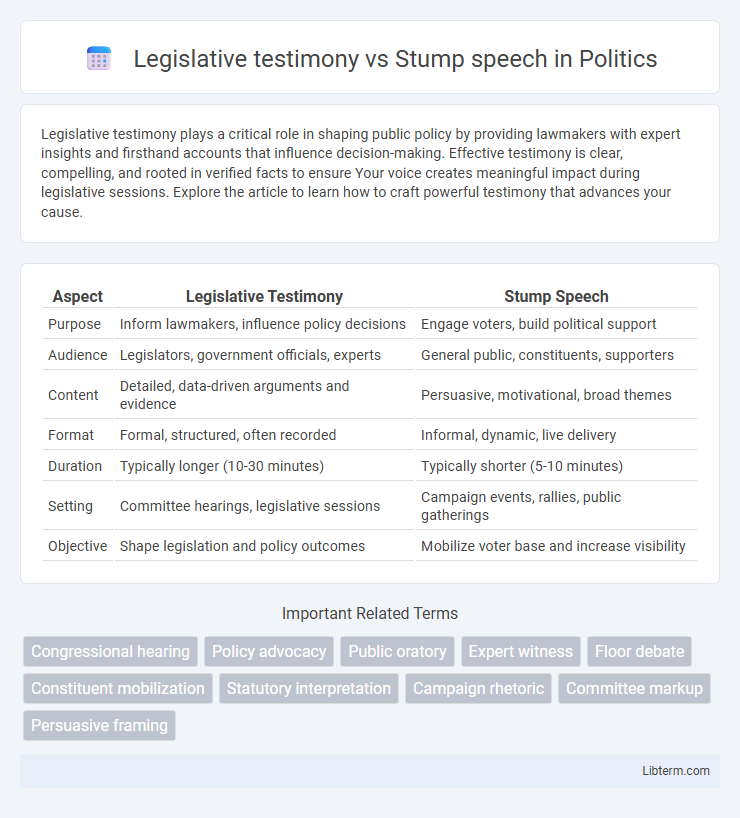Legislative testimony plays a critical role in shaping public policy by providing lawmakers with expert insights and firsthand accounts that influence decision-making. Effective testimony is clear, compelling, and rooted in verified facts to ensure Your voice creates meaningful impact during legislative sessions. Explore the article to learn how to craft powerful testimony that advances your cause.
Table of Comparison
| Aspect | Legislative Testimony | Stump Speech |
|---|---|---|
| Purpose | Inform lawmakers, influence policy decisions | Engage voters, build political support |
| Audience | Legislators, government officials, experts | General public, constituents, supporters |
| Content | Detailed, data-driven arguments and evidence | Persuasive, motivational, broad themes |
| Format | Formal, structured, often recorded | Informal, dynamic, live delivery |
| Duration | Typically longer (10-30 minutes) | Typically shorter (5-10 minutes) |
| Setting | Committee hearings, legislative sessions | Campaign events, rallies, public gatherings |
| Objective | Shape legislation and policy outcomes | Mobilize voter base and increase visibility |
Defining Legislative Testimony
Legislative testimony is a formal presentation delivered by individuals or experts to a legislative body, providing evidence, opinions, or information to influence lawmaking. Unlike stump speeches, which are designed for broad public engagement and political rallying, legislative testimony focuses on specific policy issues and is often backed by data and expert analysis. This process ensures lawmakers receive detailed insights necessary for informed decision-making during the legislative process.
What is a Stump Speech?
A stump speech is a standardized, rehearsed speech delivered by political candidates during campaigns to communicate core messages and policy positions to various audiences. Unlike legislative testimony, which is presented in formal settings like congressional hearings to provide expert information or advocate specific legislation, a stump speech aims to inspire support and rally voters. The term originated from candidates speaking atop tree stumps during the 19th century as they traveled to different locations.
Core Objectives: Legislation vs. Persuasion
Legislative testimony prioritizes providing detailed, factual information and expert opinions to influence lawmaking processes and guide legislative decisions. Stump speeches are crafted to persuade and motivate a broad audience, emphasizing key messages and emotional appeals to garner support and votes. While legislative testimony centers on informed argumentation for policy enactment, stump speeches focus on rhetorical strategies to inspire and mobilize constituents.
Audience Analysis: Lawmakers vs. Voters
Legislative testimony targets lawmakers, emphasizing detailed policy data, legal precedent, and technical implications to influence decision-making within a formal setting. Stump speeches focus on voters, using emotionally resonant narratives, clear messaging, and persuasive appeals to build support and mobilize grassroots engagement. Understanding the distinct audience--policy experts versus general constituents--shapes content, tone, and rhetorical strategy in each communication form.
Content Structure and Tone
Legislative testimony is structured with detailed, factual information aimed at influencing lawmakers, featuring precise data, expert analysis, and formal language. Stump speeches rely on emotional appeal and broad messaging, using repetitive phrases and anecdotes to energize a public audience. The tone of legislative testimony remains objective and professional, while stump speeches adopt an informal, persuasive, and passionate style.
Use of Evidence and Emotional Appeals
Legislative testimony relies heavily on factual evidence, such as statistics, expert reports, and precedents to persuade lawmakers through logical argumentation. Stump speeches prioritize emotional appeals by connecting with the audience's values and experiences, often using personal stories and rhetoric to inspire and motivate. The strategic use of evidence in testimony aims to establish credibility and inform policy decisions, while emotional appeals in stump speeches seek to build rapport and galvanize public support.
Legal Implications and Accountability
Legislative testimony carries significant legal implications as it is given under oath, making individuals accountable for accuracy and truthfulness, with potential penalties for perjury or false statements. In contrast, stump speeches, often delivered during political campaigns, lack formal legal accountability since they are opinion-driven and not sworn statements. The binding legal responsibility in legislative testimony ensures a higher level of factual integrity compared to the persuasive and rhetorical nature of stump speeches.
Timing and Settings of Delivery
Legislative testimony is delivered during formal committee hearings within legislative bodies, timed to influence specific bills or policy decisions in real-time. Stump speeches occur during election campaigns at rallies or public events, designed to persuade voters and build candidate visibility over an extended period. The structured setting of testimony contrasts with the dynamic, crowd-engaging environment of stump speeches, reflecting their distinct strategic purposes.
Impact on Public Policy and Opinion
Legislative testimony directly influences public policy by providing lawmakers with expert insights and evidence to shape legislation and regulatory decisions. Stump speeches, aimed at rallying public support, primarily impact public opinion by persuading voters and framing political narratives. While testimony targets policy development through informed dialogue, stump speeches mobilize grassroots engagement and electoral momentum.
Communicative Effectiveness and Outcomes
Legislative testimony emphasizes clarity, factual evidence, and persuasive argumentation tailored to policymakers, increasing the likelihood of influencing legislative decisions and shaping public policy. Stump speeches prioritize emotional appeal, repetition, and broad messaging to energize supporters and build voter enthusiasm, effectively mobilizing public opinion and campaign momentum. The distinct communicative strategies of each serve their respective outcomes: testimony aims for rational policy impact, while stump speeches drive electoral engagement.
Legislative testimony Infographic

 libterm.com
libterm.com